MEIOSIS I
In Meiosis I, the pairs of homologous chromosomes, made up of two sister chromatids are split into two cells. The resulting daughter cells contain one entire haploid set of chromosomes. The first meiotic division reduces the ploidy of original cell. It produces two haploid cells. Hence meiosis-I is referred to as a reductional division.
For example, a diploid human cell contains 46 chromosomes is 2n, because it contains 23 pairs of homologous chromosomes. Meiosis I consists of four stages namely,
1. Prophase I
* Leptotene
* Zygotene
* Pachytene
* Diplotene
* Diakinesis
2. Metaphase I
3. Anaphase I
4. Telophase I
Prophase I
It is the first and longest stage of meiosis I. During prophase I, chromosomal cross over occurs resulting in homologous recombination whereby DNA is exchanged between homologous chromosomes.
Homologous recombination of DNA which occurs in Meiosis I, results in significant genetic variations. It includes 5 sub stages as follows,
Leptotene: The word leptotene means ‘thin thread’ in Greek.
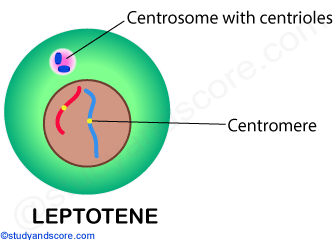
The following are the main features of this stage,
- During this stage two sister chromatids of the duplicated chromosomes condense into long thin strands clearly visible within the nucleus.
- The two sister chromatids are so tightly bound that they are not distinguishable from one other.
- This stage is of very short duration with characteristic condensation and coiling of the chromosomes.
- A centrosome with centriole is situated near pole of the nucleus. And nucleolus disappears.
Zygotene: It is also known as Zygonema. The word zygotene means ‘paired threads’ in Greek.
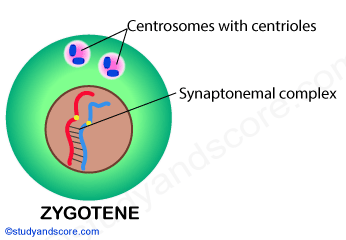
The following are the main features of this stage,
- During this stage, chromosomes line up to form homologous chromosome pairs. This stage is known as bouquet stage, as telomeres cluster at one end of the nucleus.
- One of the distinguishing features of this stage is synapsis of homologous chromosomes. Synapsis is facilitated by the assembly synaptonemal complex.
- Pairing of chromosomes occurs in a zipper-like fashion. Pairing can be
* Procentric (starting at the centromere) or
* Proterminal (starting at chromosomal ends) or
* Intermediate (starting at any other portion)
- Two chromosomes in a pair are equal in length and position of the centromere, making the pairing highly specific and exact.
- These paired chromosomes are called bivalent chromosomes as only two arms are visible
- The centrosome along with centriole divides into two equal halves, each with one centriole.
Pachytene: It is also known as pachynema. The word pachytene means ‘thick threads’ in Greek.
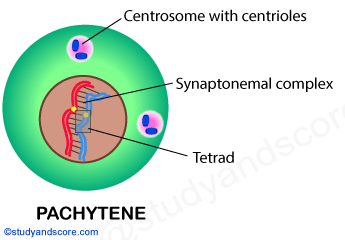
The following are the main features of this stage,
- The chromosomes condense further and become distinct, shorter and thicker.
- The two sister chromatids of each homologous chromosome become clearly visible. The bivalent thus becomes a tetrad with four chromatids.
- This is the stage where chromosomal crossing over occurs.
- In the region of chiasmata, segments of non-sister chromatids of the homologous chromosomes are exchanged and this process is called crossing over.
- The exchange of information between the non-sister chromatids results in recombination.
- Every chromosome now has a complete set of information and all the gaps are removed by the end of this process.
Diplotene: It is also known as diplonema. The word diplotene means ‘two threads’ in Greek.
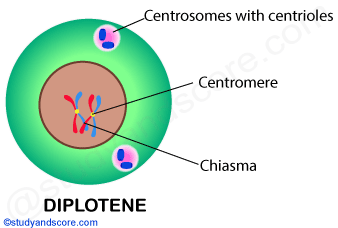
The following are the important features of this stage,
- During this stage the synaptonemal complex gets degraded and due to this degradation the homologous chromosomes separate from each other except at the chiasmata.
- Due to this separation the dual nature of a bivalent becomes apparent and hence the name diplotene.
- The chromosomes uncoil a little to allow transcription of DNA.
- The chiasmata regions remain on the chromosomes until they are separated in the anaphase.
It is interesting to know that, in the oogenesis of humans the developing oocytes in foetal stage stop at this stage of diplotene before birth. This state is referred to as the dictyotene stage and it remains in this suspended stage until puberty.
Diakinesis: The main feature of this stage is terminalization
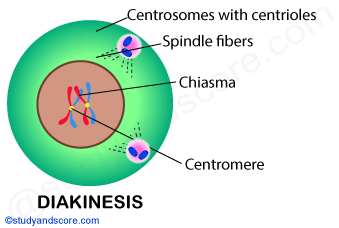
The following are the changes in Diakinesis stage:
- The Chromosomes continue to contract.
- The separation of chromosome becomes complete due to terminalisation. The separation starts from the centromeres and goes towards the end and hence the name terminalisation.
- The nucleolus and nuclear membrane disappear
- The formation of spindle starts from the centrioles of centromeres
Metaphase I
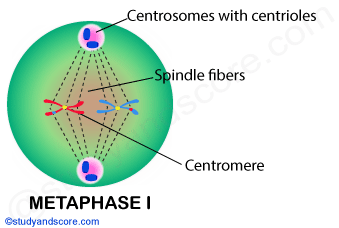
The following are the changes in Metaphase I stage:
- The nuclear membrane disappears
- Centrioles reach the opposite poles
- The spindle fibres become prominent and get connected to the centromere of the homologous chromosomes.
- The bivalents align on the equatorial plane.
Anaphase I
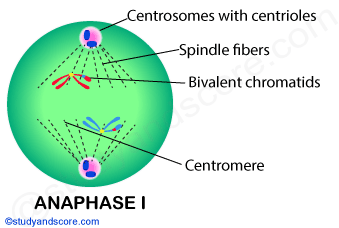
The following are the changes taking place in Anaphase I:
- The two chromosomes of each bivalent with chromatids still attached to the centromere separate from each other and move to the opposite poles of the cell.
- Thus, only one chromosome of each homologous pair reaches each pole.
- Consequently at each pole only half the number of chromosomes (haploid) is received.
Telophase I
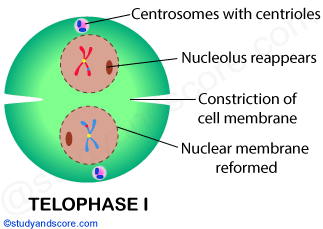
This is the last stage of meiosis I. The following are the changes taking place in this stage:
- Reorganization of the chromosomes at poles occurs to form two haploid nuclei.
- Nuclear membrane is reformed around the polarised group of chromosomes.
- Nucleolus also re-appears.
- The spindle disappears.
- The cell membrane constricts and two daughter cells are formed.
- The second meiotic division may follow immediately or after a short inter phase.
Cytokinesis
Many a times, cytokinesis does not occur after Meiosis I, but it occurs simultaneously after Meiosis II. If the meiosis I cell proceeds to cytokinesis the below are the events,
- The cell membrane constricts and two daughter cells are formed.
- These daughter cells have chromosome consisting of one of its original chromatids and the other has the mixture of segments from its own and a segment of chromatid from its homologue.
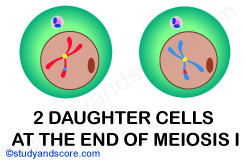
- The formation of nuclear membrane and the nucleus is completed at this stage.
- And finally the daughter cells are ready to proceed to the next stare, Meiosis II.
MEIOSIS II
The second meiotic division is very much similar to mitosis. But the only difference is that the DNA does not duplicate whereas the centromeres do duplicate. Meiosis II is also called as the mitotic or equational phase.
Prophase II
The events of prophase II are similar to mitotic prophase.
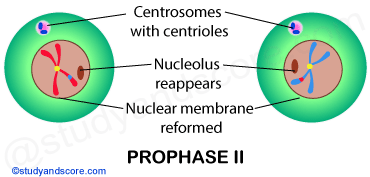
- Chromatids have widely separated arms.
- Nucleolus and nuclear membrane disappear.
- Spindle fibres are formed at each pole.
Metaphase II
The following are the events occurring in Metaphase II
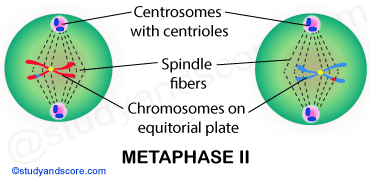
- Chromosomes move to the centre of the equatorial plane.
- They get attached to spindle fibres centromere.
- The centromeres divide.
Anaphase II
The following are the events occurring in Anaphase II
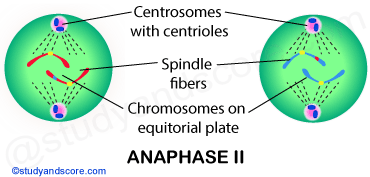
- The sister chromatids separate from one another
- The sister chromatids are pulled to opposite poles due to contraction of spindle fibres
- The chromatids after reaching the poles are called chromosomes
Telophase II
The following are the events occurring in Telophase II
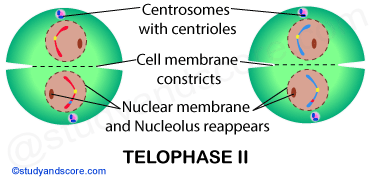
- Reconstitution of nuclei takes place
- The chromosomes begin to uncoil and become thin.
- Nucleolus and nuclear membrane reappear at each pole.
Cytokinesis
Cytokinesis of the daughter cells cause the formation of two cells, in other words from the two daughter cells of the first meiotic division, four cells are produced each with haploid set of chromosomes.
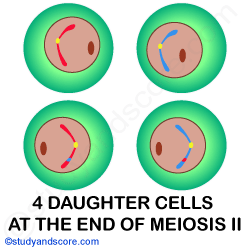
SIGNIFICANCE OF MEIOSIS
Adapting to the constant changing environment and ability to colonize in new environments are the keys for the long-term survival of a species. To attain these goals it is necessary for the offsprings to be different from their parents and also different from each other. Meiotic cell division helps in achieving these objectives in the following ways:
Maintain constant chromosome number
- Sexual reproduction involves production of special sex cells called gametes, which further fuse together to produce a new organism.
- In this case each gamete must contain half the number of chromosomes of the parent. It is therefore essential that a reductional division occurs at this stage of the life cycle of the sexually reproducing organisms.
- Thus, meiosis helps in maintaining constant chromosome number. Consequently from a diploid cell, haploid gametes are produced which in turn unite to form a diploid zygote cell.
Recombination of genes
- During Prophase I of Meiosis, equivalent portions of homologous chromosomes are exchanged and in this way new genetic recombination are produced.
- Genetic recombination is essential to the process of evolution.
- The varied stock of individuals produced as a result of meiosis permit natural selection of best suited species.
Creation of genetic variation
- During Metaphase I of Meiosis, pairs of homologous chromosomes randomly arrange themselves on the equatorial plate.
- Though each one of the pair determines the same general features, they differ in detailed features.
- The random distribution and consequent independent assortment of these chromosomes produces new genetic combinations.

- Give a complete picture of Meiosis I.
- Write about Telophase I of Meiosis I.
- What are the phases included in the Meiosis I
- Explain the events of Meiosis II.
- Differentiate between the cytokinesis of meiosis I and meiosis II.
- List the phases included in the Meiosis II.
- Write about the significance of meiosis cell division.
- Mention the importance of meiosis in creation of genetic variation.
- Share with your friends! -















Login to post your comment here...
- or with social Account -